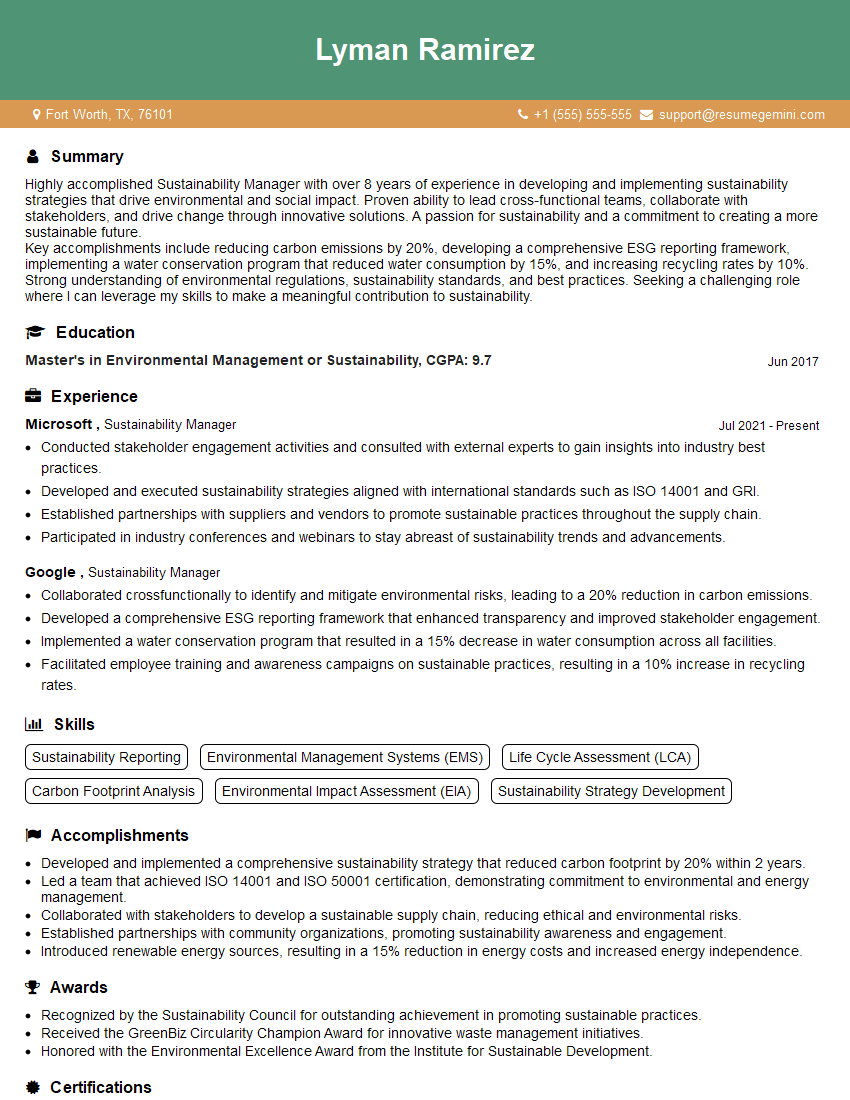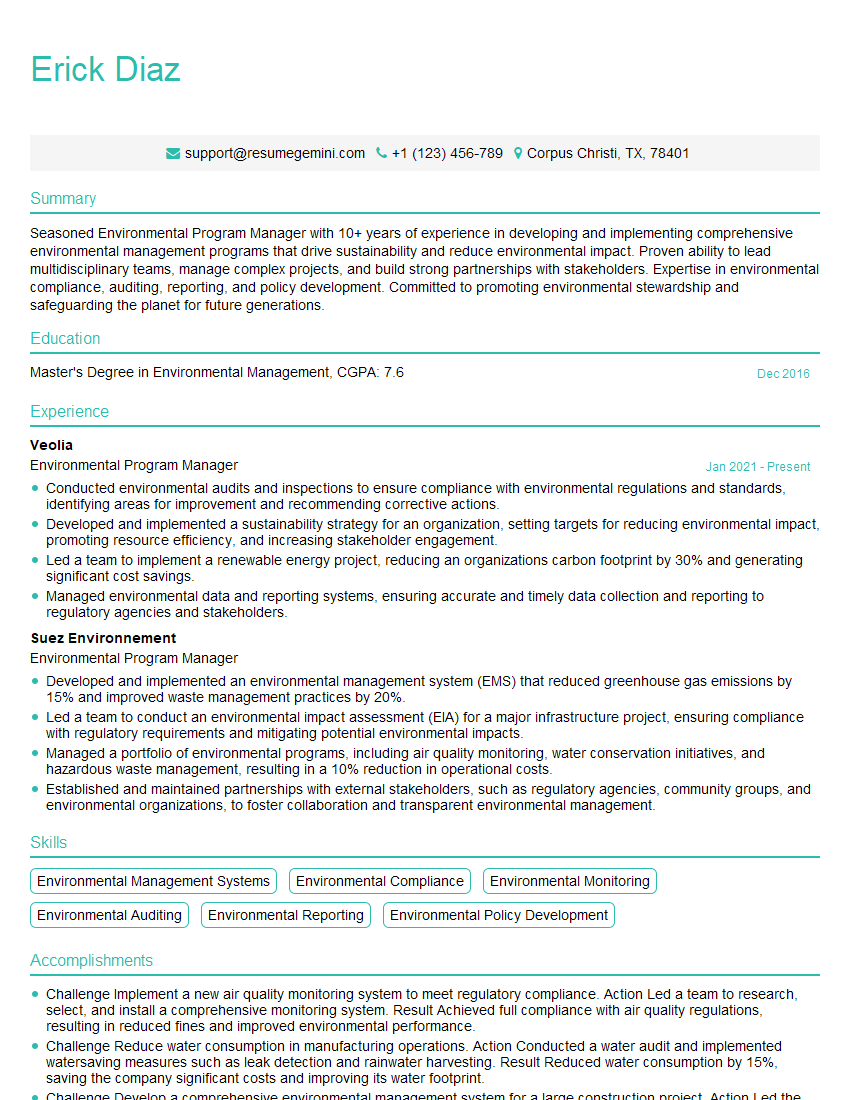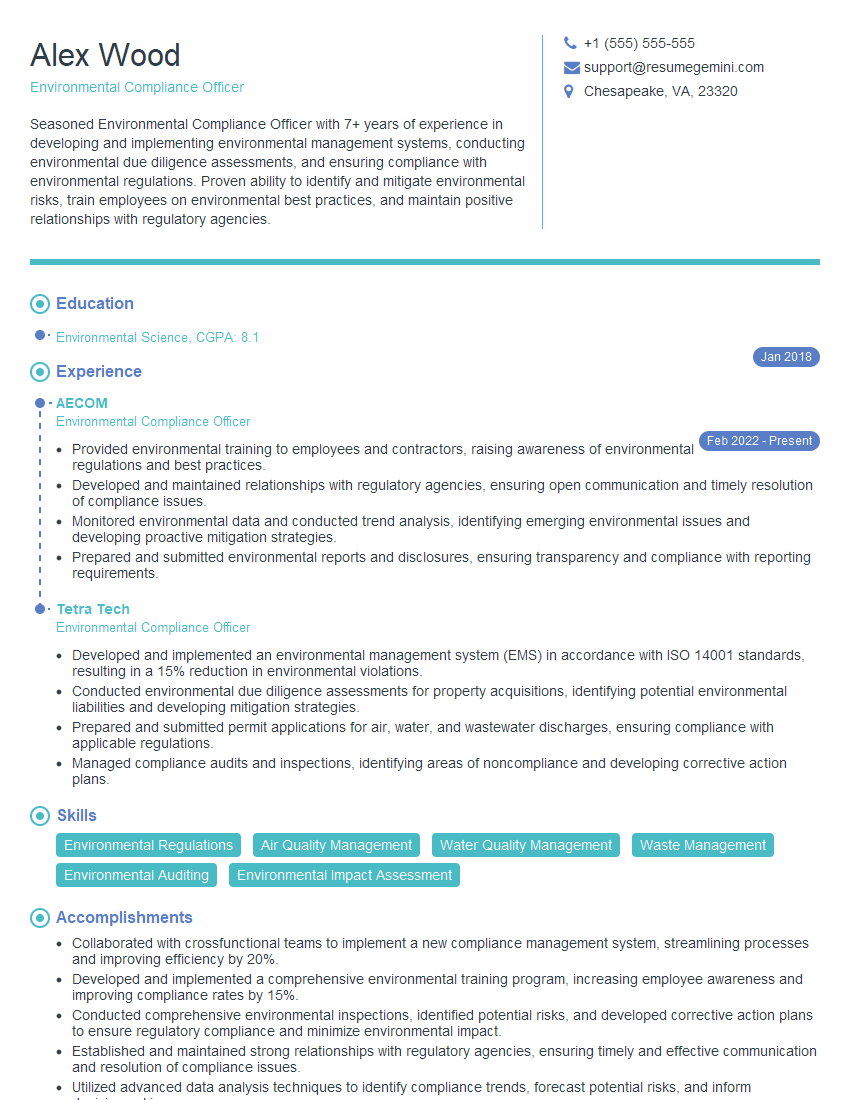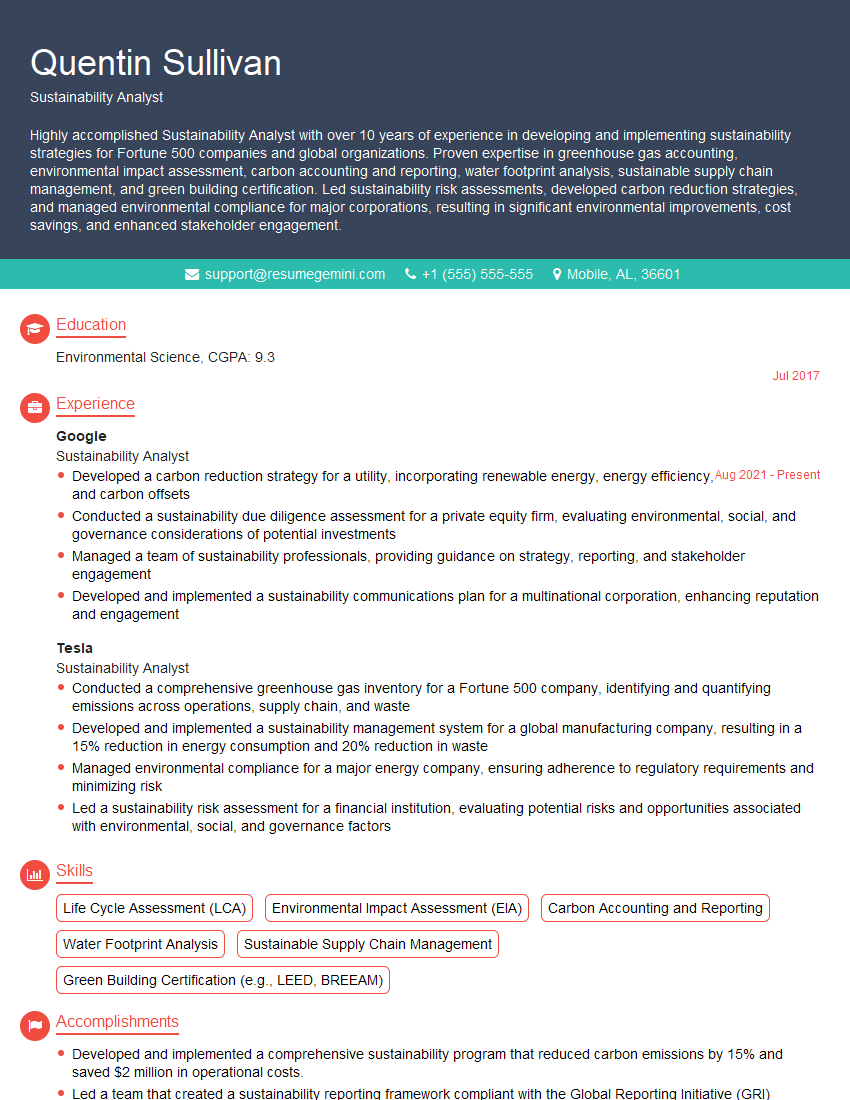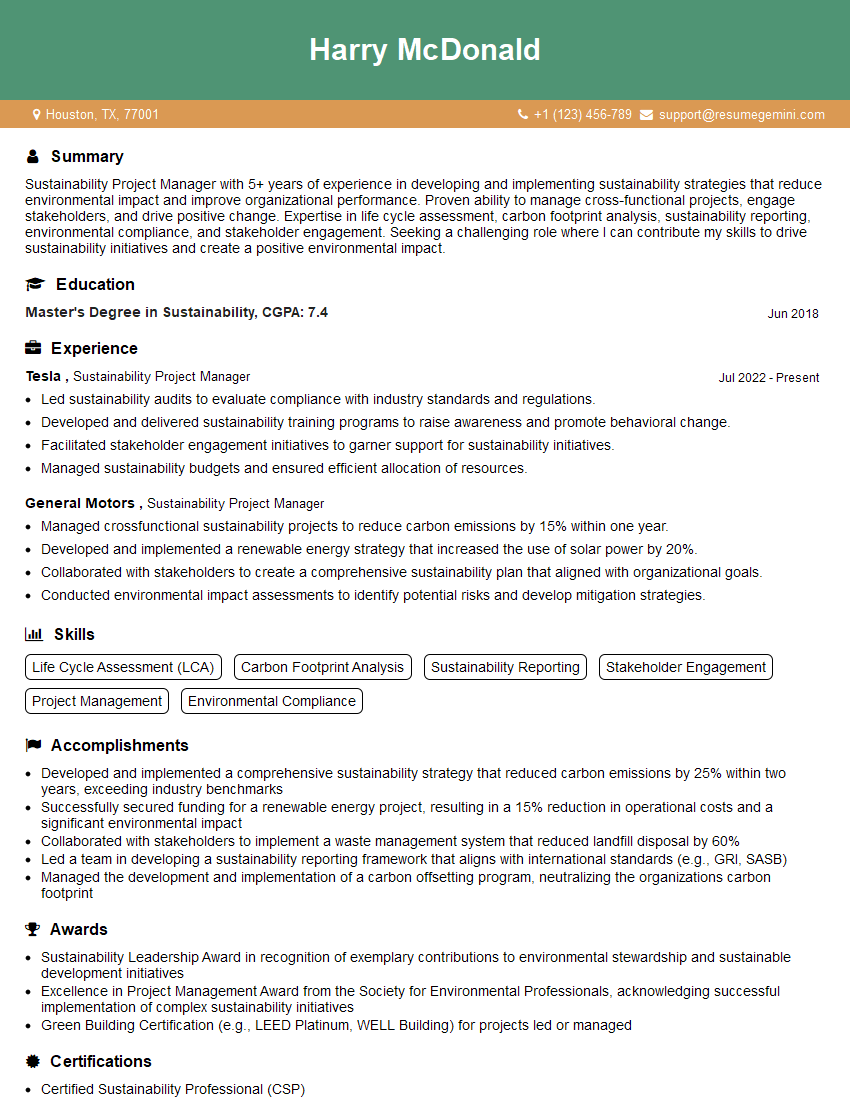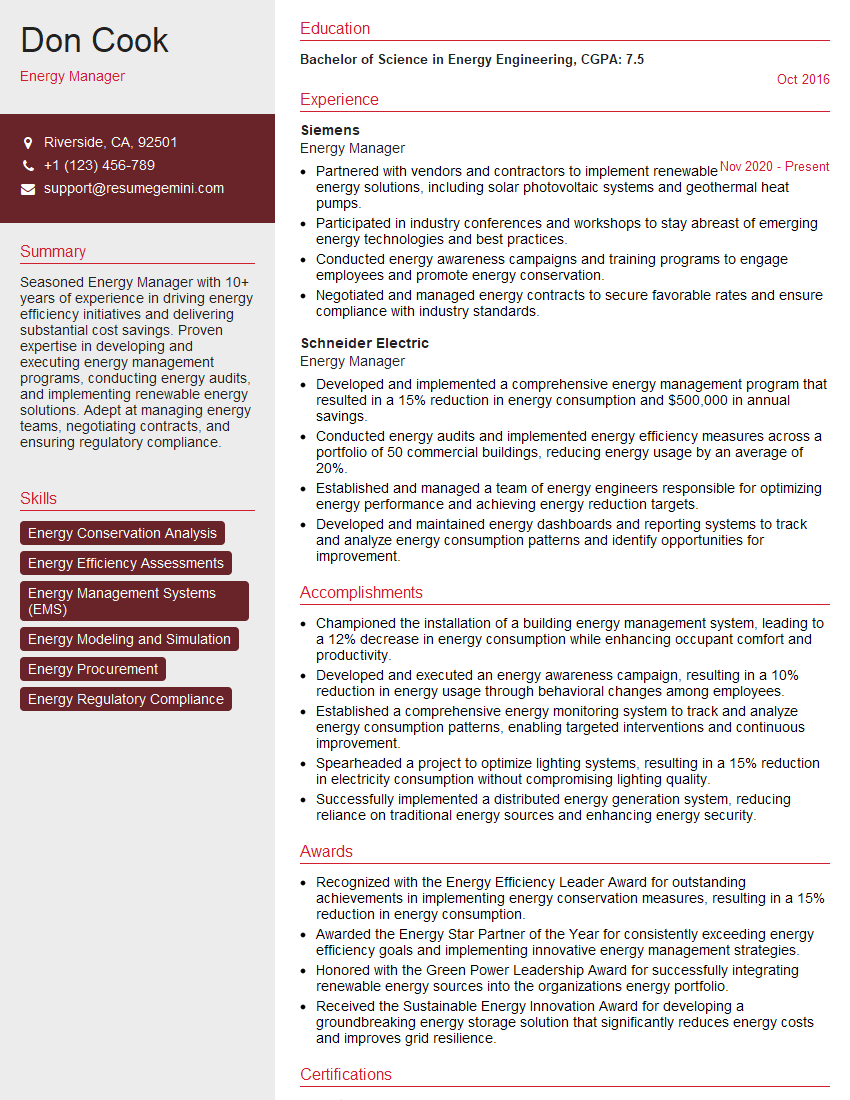Interviews are more than just a Q&A session—they’re a chance to prove your worth. This blog dives into essential Sustainability in Production interview questions and expert tips to help you align your answers with what hiring managers are looking for. Start preparing to shine!
Questions Asked in Sustainability in Production Interview
Q 1. Define Life Cycle Assessment (LCA) and explain its application in production.
Life Cycle Assessment (LCA) is a standardized methodology used to evaluate the environmental impacts associated with a product, process, or service throughout its entire life cycle. This encompasses everything from raw material extraction and processing to manufacturing, transportation, use, and eventual disposal or recycling.
In production, LCA helps businesses identify environmental hotspots – stages where the impact is most significant. For example, an LCA might reveal that the energy-intensive manufacturing stage of a particular product contributes most to greenhouse gas emissions. This information can then guide strategic improvements, such as switching to renewable energy sources or optimizing production processes to reduce waste and resource consumption.
Application in Production:
- Identifying Environmental Hotspots: Pinpointing the stages with the largest environmental impact.
- Comparative Analysis: Evaluating the environmental performance of different materials, processes, or product designs.
- Setting Improvement Targets: Establishing measurable goals to reduce environmental footprints.
- Communicating Sustainability Performance: Providing transparent and credible environmental information to stakeholders.
For instance, a clothing manufacturer might use LCA to compare the environmental impact of using organic cotton versus conventional cotton, considering factors such as water usage, pesticide application, and transportation distances.
Q 2. Describe different sustainable sourcing strategies for raw materials.
Sustainable sourcing strategies prioritize environmentally and socially responsible procurement of raw materials. This goes beyond simply finding the cheapest option, focusing on minimizing the negative impacts throughout the entire supply chain.
- Certified Sustainable Materials: Sourcing materials certified by organizations like the Forest Stewardship Council (FSC) for timber, or the Fairtrade International for agricultural products, guarantees adherence to specific environmental and social standards.
- Recycled Materials: Using recycled materials reduces reliance on virgin resources and minimizes waste sent to landfills. This could involve incorporating recycled plastics, metals, or paper into products.
- Locally Sourced Materials: Reducing transportation distances by sourcing materials from local suppliers decreases fuel consumption and associated emissions. This also strengthens local economies.
- Traceability and Transparency: Implementing systems to track materials from origin to end-product increases accountability and helps identify and address potential environmental or social issues within the supply chain.
- Collaboration with Suppliers: Working closely with suppliers to implement sustainable practices throughout their operations, fostering a shared responsibility for environmental stewardship.
For example, a furniture manufacturer could source FSC-certified wood, utilize recycled metal components, and collaborate with local wood suppliers to minimize transportation costs and environmental impact.
Q 3. What are the key environmental impacts of your industry, and how can they be mitigated?
The specific environmental impacts vary significantly across industries. However, some common impacts in many manufacturing sectors include:
- Greenhouse Gas Emissions: From energy consumption in manufacturing processes and transportation.
- Water Pollution: From wastewater discharge containing chemicals or pollutants.
- Air Pollution: From emissions of particulate matter, volatile organic compounds (VOCs), and other pollutants.
- Waste Generation: Including solid waste, hazardous waste, and wastewater.
- Resource Depletion: Overuse of raw materials, water, and energy.
Mitigation Strategies:
- Energy Efficiency Improvements: Implementing energy-saving technologies, optimizing processes, and using renewable energy sources.
- Waste Reduction and Management: Implementing waste hierarchy (reduce, reuse, recycle), improving material efficiency, and responsible waste disposal.
- Water Conservation: Implementing water-efficient technologies, recycling wastewater, and reducing water consumption.
- Pollution Control Technologies: Installing air and water treatment systems to minimize emissions and discharges.
- Sustainable Sourcing: Selecting environmentally friendly materials and working with responsible suppliers.
- Lifecycle Thinking: Considering the environmental impacts throughout the entire product life cycle, from design to disposal.
For instance, a manufacturing plant might install solar panels to reduce reliance on fossil fuels, implement a closed-loop water system to recycle wastewater, and invest in advanced filtration systems to minimize air emissions.
Q 4. Explain your understanding of circular economy principles in production.
The circular economy is an economic model aimed at minimizing waste and maximizing the utilization of resources. Instead of a linear ‘take-make-dispose’ model, it promotes a cyclical approach where resources are kept in use for as long as possible, extracting maximum value before being recovered and regenerated at the end of each service life.
Circular Economy Principles in Production:
- Design for Durability and Reusability: Creating products designed to last longer and be easily repaired or reused.
- Design for Disassembly and Recycling: Making products easier to dismantle and recycle at the end of their life.
- Material Selection: Prioritizing the use of recyclable, renewable, and biodegradable materials.
- Waste Minimization: Reducing waste generation through improved process efficiency and innovative design.
- Closed-Loop Systems: Creating systems where waste from one process becomes the input for another.
- Product-Service Systems: Offering products as services rather than selling them outright, retaining ownership and responsibility for the product throughout its life cycle. (e.g., leasing instead of selling)
For example, a company might design a phone with easily replaceable batteries and modular components, allowing for repairs and upgrades rather than discarding the entire device. They might also establish a take-back program for end-of-life products to recover valuable materials for reuse.
Q 5. How would you measure and track the environmental performance of a production facility?
Measuring and tracking environmental performance requires a systematic approach that combines data collection, analysis, and reporting. Key metrics and methods include:
- Environmental Key Performance Indicators (KPIs): Defining specific, measurable, achievable, relevant, and time-bound (SMART) KPIs, such as energy consumption per unit produced, water usage per unit, waste generation rates, greenhouse gas emissions, and air/water pollutant discharges.
- Environmental Management System (EMS): Implementing an EMS, such as ISO 14001, provides a framework for systematically managing environmental aspects and impacts. It includes procedures for monitoring, measuring, and improving environmental performance.
- Environmental Monitoring Tools: Utilizing software and hardware for monitoring energy and water consumption, emissions, and waste generation in real-time.
- Life Cycle Assessments (LCAs): Conducting periodic LCAs to evaluate the overall environmental footprint of products and processes.
- Environmental Audits: Regularly conducting environmental audits to identify areas for improvement and ensure compliance with regulations and standards.
- Data Reporting and Analysis: Establishing systems for collecting, analyzing, and reporting environmental data to track progress and identify trends.
Data should be collected regularly and accurately, and progress tracked over time to demonstrate improvements and inform future decision-making. This data can be used to establish baselines, set targets, and measure the effectiveness of implemented improvement measures.
Q 6. Describe your experience with ISO 14001 or other relevant environmental management systems.
I have extensive experience with ISO 14001, the internationally recognized standard for environmental management systems. I’ve been involved in the implementation and maintenance of ISO 14001 in several manufacturing facilities. This included leading internal audits, conducting management reviews, and participating in external certification audits. My responsibilities encompassed:
- Developing and implementing environmental policies and procedures.
- Identifying and assessing environmental aspects and impacts of operations.
- Setting environmental objectives and targets, and tracking progress.
- Managing environmental risks and compliance with environmental regulations.
- Developing and implementing emergency preparedness and response plans.
- Providing training to employees on environmental issues and procedures.
Beyond ISO 14001, I’m familiar with other relevant standards and guidelines, such as the Global Reporting Initiative (GRI) for sustainability reporting and the Carbon Disclosure Project (CDP) for climate change reporting. My experience spans various industries and highlights the importance of a structured approach to environmental management, aligning organizational goals with environmental sustainability.
Q 7. What strategies would you employ to reduce energy consumption in a manufacturing process?
Reducing energy consumption in a manufacturing process requires a multi-pronged approach focusing on both operational efficiency and technological upgrades.
- Process Optimization: Analyzing the manufacturing process to identify areas where energy is wasted. This might involve streamlining operations, improving material flow, and reducing idle time.
- Equipment Upgrades: Replacing outdated or inefficient equipment with more energy-efficient alternatives. This includes using high-efficiency motors, advanced control systems, and energy-efficient lighting.
- Renewable Energy Sources: Incorporating renewable energy sources like solar, wind, or geothermal power to reduce reliance on fossil fuels.
- Energy Management System (EnMS): Implementing an EnMS, such as ISO 50001, provides a systematic approach to managing energy performance.
- Building Envelope Improvements: Improving building insulation, sealing air leaks, and optimizing HVAC systems to reduce energy loss.
- Employee Training: Educating employees on energy-saving practices and promoting a culture of energy conservation.
- Data Monitoring and Analysis: Regularly monitoring and analyzing energy consumption data to identify areas for improvement and track progress.
For instance, a factory might install variable frequency drives (VFDs) on motors to adjust power according to demand, install LED lighting, and implement a building automation system to optimize HVAC operations. By combining these strategies, significant reductions in energy consumption can be achieved, leading to lower operating costs and a reduced carbon footprint.
Q 8. How would you implement a waste reduction program in a production setting?
Implementing a waste reduction program in a production setting requires a systematic approach, focusing on the ‘5 R’s’: Refuse, Reduce, Reuse, Recycle, and Recover. It’s not just about cleaning up after production; it’s about redesigning the process to minimize waste generation from the outset.
Refuse: Avoid unnecessary materials. This could involve switching to a more efficient design that uses fewer components or sourcing materials from suppliers who prioritize minimizing packaging.
Reduce: Minimize material use at every stage. This might include optimizing cutting patterns in fabric production to reduce scrap or implementing lean manufacturing principles to streamline processes and eliminate waste.
Reuse: Repurpose materials whenever possible. For example, scrap metal could be reused in the foundry or offcuts of wood could be used for smaller projects.
Recycle: Implement a robust recycling program. This necessitates proper sorting and handling of materials, potentially involving partnerships with specialized recycling facilities. The choice of materials at the beginning of the production process should also consider their recyclability.
Recover: Explore energy recovery from waste. In some cases, waste materials can be used for energy generation, reducing reliance on fossil fuels and decreasing disposal costs.
For instance, I worked with a textile manufacturer who implemented a closed-loop system. They collected fabric scraps, processed them, and used the recycled fibers in their new production runs, significantly reducing landfill waste and material costs.
Q 9. Explain your understanding of carbon footprint accounting and reduction strategies.
Carbon footprint accounting involves measuring the total greenhouse gas emissions associated with a product, process, or organization. It quantifies the impact of activities across the entire lifecycle, from raw material extraction to end-of-life disposal. Reduction strategies focus on minimizing these emissions.
A thorough carbon footprint assessment includes:
Scope 1: Direct emissions from sources owned or controlled by the organization (e.g., on-site fuel combustion).
Scope 2: Indirect emissions from the generation of purchased electricity, heat, or steam.
Scope 3: All other indirect emissions across the value chain (e.g., emissions from transportation, suppliers, and waste disposal). This is usually the largest portion.
Reduction strategies involve various approaches:
Energy Efficiency: Improving equipment efficiency, optimizing production processes, and investing in energy-saving technologies.
Renewable Energy: Transitioning to renewable energy sources, like solar or wind power, to reduce reliance on fossil fuels.
Sustainable Sourcing: Selecting suppliers with strong sustainability credentials and prioritizing lower-emission materials.
Waste Management: Implementing effective waste reduction and recycling programs, as discussed earlier.
Carbon Offsetting: Investing in projects that remove or reduce greenhouse gas emissions to compensate for unavoidable emissions.
For example, in a previous role, we implemented a comprehensive carbon accounting system and discovered that transportation accounted for a significant portion of our Scope 3 emissions. We then optimized our logistics, shifted to more fuel-efficient vehicles, and collaborated with suppliers to consolidate shipments, achieving a substantial reduction.
Q 10. What are the key challenges in achieving sustainable supply chains?
Achieving sustainable supply chains presents several significant challenges:
Lack of Transparency: It can be difficult to track and monitor environmental and social impacts across the entire supply chain, especially with numerous suppliers and intermediaries.
Data Availability and Reliability: Accurate and consistent data on emissions, waste, and other sustainability metrics can be lacking, making it difficult to assess the true environmental footprint.
Supplier Engagement and Collaboration: Engaging and motivating all suppliers to adopt sustainable practices requires strong communication, collaboration, and often financial incentives.
Cost Considerations: Implementing sustainable practices can involve upfront costs, potentially impacting profitability. This requires a long-term perspective and potentially investment in new technologies.
Regulatory Complexity: Navigating diverse and evolving environmental regulations across different countries and regions can be complex and challenging.
Consumer Demand and Behavior: Consumer demand for sustainable products plays a significant role. Understanding and responding to these demands is essential.
For instance, ensuring ethical sourcing of raw materials like cocoa or palm oil often requires tracing them back through multiple tiers of the supply chain, which can be incredibly challenging due to a lack of traceability and transparency in some areas.
Q 11. How do you assess the environmental impact of packaging and transportation?
Assessing the environmental impact of packaging and transportation requires a Life Cycle Assessment (LCA). This involves evaluating the environmental burdens associated with each stage of a product’s life, from material extraction to disposal. For packaging, this includes the raw materials used, manufacturing processes, transportation to the production facility, and end-of-life management (recycling, composting, or landfill).
For transportation, the assessment considers fuel consumption, emissions (CO2, NOx, particulate matter), vehicle type, distance traveled, and mode of transport (road, rail, sea, air). Factors like packaging weight and efficiency of packing also significantly impact the transportation impact.
Tools and methodologies, such as those provided by the ISO 14040 series of standards, provide frameworks for conducting LCAs. The results can then inform choices about sustainable packaging materials (e.g., recycled content, biodegradable options), optimized packaging design (reducing material use), and efficient transportation strategies (consolidated shipping, using alternative fuel sources).
For example, a shift from heavy glass bottles to lightweight plastic bottles might reduce transportation emissions, but it needs to be weighed against the environmental impact of plastic production and its lower recyclability.
Q 12. Describe your experience with water management and conservation in production.
Water management and conservation in production involve optimizing water usage throughout the manufacturing process, aiming to minimize water consumption, improve water quality, and protect water resources. This can include several strategies:
Water Audits: Conducting thorough assessments to identify water-intensive processes and areas for improvement.
Leak Detection and Repair: Implementing programs to promptly identify and fix leaks in piping and equipment.
Water Recycling and Reuse: Treating and reusing wastewater within the production process whenever feasible.
Process Optimization: Improving production processes to reduce water consumption. For example, using more efficient cooling systems or implementing dry processes instead of water-intensive ones.
Water-Efficient Technologies: Investing in water-saving technologies like low-flow fixtures and high-efficiency equipment.
In a previous project, we implemented a rainwater harvesting system at a food processing plant. The collected rainwater was used for non-potable purposes, reducing the plant’s reliance on municipal water supplies and lowering its overall water footprint.
Q 13. What is your experience with renewable energy integration in production processes?
Renewable energy integration in production processes involves transitioning from fossil fuels to renewable energy sources like solar, wind, hydro, or biomass. This requires a holistic approach, evaluating the feasibility and cost-effectiveness of different renewable energy options based on site-specific factors.
Key aspects include:
Energy Audits: Assessing current energy consumption to determine the potential for renewable energy integration.
Renewable Energy System Selection: Choosing appropriate renewable technologies based on factors like available space, sunlight exposure, wind resources, and grid connection capabilities.
System Installation and Maintenance: Proper installation, commissioning, and ongoing maintenance are essential for efficient and reliable operation.
Grid Integration: In some cases, integration with the electricity grid might require upgrades or changes to infrastructure.
Energy Storage: Considering energy storage solutions to address intermittency issues with some renewable energy sources (e.g., solar or wind).
I’ve been involved in several projects integrating solar photovoltaic (PV) systems into manufacturing facilities. This not only reduced reliance on fossil fuels but also significantly lowered energy costs and enhanced the company’s sustainability profile.
Q 14. Explain your understanding of different environmental regulations and compliance requirements.
Understanding environmental regulations and compliance requirements is crucial for sustainable production. These regulations vary significantly depending on location, industry, and the specific environmental impacts of a company’s operations. Key areas often covered include:
Air Quality: Regulations limiting emissions of pollutants such as particulate matter, NOx, and SOx.
Water Quality: Standards for wastewater discharge, including limits on pollutants and water usage.
Waste Management: Regulations governing waste disposal, hazardous waste management, and recycling.
Greenhouse Gas Emissions: Regulations on carbon emissions, particularly in energy-intensive industries.
Chemical Management: Restrictions on the use of hazardous chemicals and requirements for reporting and managing chemical risks.
Environmental Impact Assessments (EIAs): Requirements for conducting EIAs before major projects to assess potential environmental impacts.
Compliance involves developing and implementing environmental management systems (EMS), such as ISO 14001, regularly monitoring emissions and waste, obtaining necessary permits, and ensuring that all activities adhere to legal requirements. Failure to comply can result in significant penalties and reputational damage.
For example, I’ve helped companies navigate the complex regulations related to hazardous waste management, ensuring proper disposal, tracking, and documentation to avoid non-compliance issues and potential fines.
Q 15. How would you conduct an environmental risk assessment for a production facility?
Conducting an environmental risk assessment for a production facility involves a systematic process to identify, analyze, and evaluate potential environmental impacts. Think of it like a thorough medical checkup for your factory. We begin by defining the facility’s boundaries and identifying all potential environmental aspects, such as energy consumption, water usage, waste generation (solid, liquid, gaseous), and emissions to air and water. Next, we assess the significance of each aspect using various methods, including legislation compliance checks, material flow analysis, and Life Cycle Assessment (LCA). This involves determining the likelihood and severity of potential environmental harm. For example, a high likelihood of a chemical spill with high toxicity would receive a higher risk score than a low likelihood of minor air emissions. Finally, we prioritize the risks based on their scores and develop mitigation strategies, which could involve implementing new technologies, changing production processes, or improving waste management systems. This entire process is documented and regularly reviewed to ensure ongoing effectiveness.
Example: In a previous assessment for a textile factory, we identified high water consumption as a significant risk due to dye processing. We then recommended implementing a closed-loop water recycling system, which reduced water usage by 40% and minimized wastewater discharge, thereby lowering the environmental risk.
Career Expert Tips:
- Ace those interviews! Prepare effectively by reviewing the Top 50 Most Common Interview Questions on ResumeGemini.
- Navigate your job search with confidence! Explore a wide range of Career Tips on ResumeGemini. Learn about common challenges and recommendations to overcome them.
- Craft the perfect resume! Master the Art of Resume Writing with ResumeGemini’s guide. Showcase your unique qualifications and achievements effectively.
- Don’t miss out on holiday savings! Build your dream resume with ResumeGemini’s ATS optimized templates.
Q 16. How do you communicate sustainability initiatives to stakeholders?
Communicating sustainability initiatives effectively involves tailoring the message to the specific stakeholder group. We use a multi-pronged approach encompassing various communication channels. For internal stakeholders (employees), we utilize regular newsletters, town hall meetings, and training programs to promote engagement and ownership of sustainability goals. For external stakeholders (investors, customers, communities), we employ annual sustainability reports, website content, social media engagement, and participation in industry events. Transparency is key; we provide clear, concise information about our progress towards our targets, challenges we encounter, and future plans. Visual aids, such as infographics and videos, are crucial in making complex data easily digestible. We also actively solicit feedback from stakeholders to ensure our communication remains relevant and impactful.
Example: For a recent client, we created a compelling infographic showcasing their carbon footprint reduction journey, highlighting key achievements and future goals. This resonated well with investors and customers, demonstrating their commitment to environmental responsibility.
Q 17. Describe your experience with data analysis and reporting related to sustainability metrics.
My experience with data analysis and reporting on sustainability metrics is extensive. I’m proficient in using various software tools, including environmental management systems (EMS) software and data analytics platforms, to collect, process, and analyze a wide range of sustainability indicators such as energy consumption, water usage, waste generation, greenhouse gas emissions, and material usage. I employ statistical methods to track trends, identify areas for improvement, and measure the effectiveness of implemented sustainability initiatives. This data is then used to create comprehensive sustainability reports, which adhere to globally recognized standards like GRI (Global Reporting Initiative) and SASB (Sustainability Accounting Standards Board). These reports are meticulously crafted to showcase our achievements, highlight areas needing attention, and transparently communicate our sustainability performance to stakeholders.
Example: In a recent project, I used statistical modeling to forecast the reduction in greenhouse gas emissions based on various energy efficiency improvement scenarios. This data-driven approach enabled the client to make informed decisions about resource allocation and investment priorities.
Q 18. How would you manage conflicts between sustainability goals and production efficiency?
Managing conflicts between sustainability goals and production efficiency often requires a strategic and collaborative approach. It’s not about choosing one over the other; rather, it’s about finding synergies and innovative solutions. This involves identifying the root causes of the conflict, for example, high energy consumption due to an inefficient manufacturing process. We then brainstorm innovative solutions that address both sustainability and efficiency. This could include investing in energy-efficient technologies, optimizing production processes, or implementing circular economy principles (reducing, reusing, recycling). A crucial step is establishing clear targets and metrics that balance both production efficiency and environmental performance. For instance, we might set a target to reduce energy consumption by 20% while maintaining or exceeding production output. Regular monitoring and adjustments are essential to ensure we’re on track towards our goals.
Example: In one case, we helped a manufacturing company reduce energy consumption by 25% by implementing a smart energy management system, which also led to a 10% increase in production efficiency due to optimized energy allocation.
Q 19. What innovative sustainability technologies or practices are you familiar with?
I’m familiar with a range of innovative sustainability technologies and practices. These include:
- Renewable energy sources: Solar, wind, and geothermal energy offer sustainable alternatives to fossil fuels.
- Circular economy principles: Designing products for durability, repairability, and recyclability reduces waste and resource depletion.
- Industrial symbiosis: Collaborating with other industries to use byproducts as raw materials for other processes, minimizing waste and resource usage.
- Smart manufacturing: Utilizing data analytics and automation to optimize resource consumption and reduce emissions.
- Green building technologies: Incorporating sustainable materials, energy-efficient designs, and renewable energy systems in factory buildings.
- Waste-to-energy technologies: Converting organic waste into biogas or other forms of renewable energy.
The selection of appropriate technologies depends on the specific context of the production facility and its sustainability goals.
Q 20. Describe your experience with stakeholder engagement related to sustainability.
My experience with stakeholder engagement related to sustainability is built on fostering open communication and collaboration. I believe in proactively engaging stakeholders from the outset of any project, ensuring their perspectives and concerns are considered throughout the process. This involves conducting regular meetings, workshops, and surveys to gather feedback. We use various communication channels to keep stakeholders informed about our progress, challenges, and achievements. For instance, regular progress reports, presentations, and social media updates keep stakeholders informed. Building trust and transparency is vital, and addressing concerns promptly and openly fosters a collaborative relationship. It’s essential to understand their specific needs and expectations, tailoring our communication and engagement strategies accordingly. We frequently create platforms for dialogue, allowing for open feedback and two-way communication.
Example: In a community engagement initiative for a new factory project, we actively engaged local residents through public forums, addressing their concerns regarding potential environmental impacts and offering reassurance through transparent communication and collaborative problem-solving.
Q 21. How would you develop and implement a sustainability strategy for a new product line?
Developing and implementing a sustainability strategy for a new product line requires a holistic and proactive approach. We begin by conducting a Life Cycle Assessment (LCA) to evaluate the environmental impacts of the product throughout its entire lifecycle, from raw material extraction to end-of-life disposal. This informs the design and manufacturing processes. We then identify key sustainability priorities, such as reducing carbon footprint, minimizing water usage, and selecting sustainable materials. These priorities are integrated into the product design and manufacturing processes. This involves selecting sustainable materials, optimizing production processes to reduce waste and energy consumption, and designing products for durability and recyclability. We establish clear sustainability targets and metrics, which are tracked and reported regularly. The entire process is guided by best practices and relevant standards. Furthermore, a robust supply chain management approach is crucial, ensuring suppliers adhere to our sustainability requirements. We engage our suppliers in open communication and collaboration to achieve common goals. Throughout this process, we communicate our sustainability strategy transparently to all stakeholders.
Example: When developing a new line of sustainable packaging, we worked closely with our suppliers to identify and use recycled materials, reducing our reliance on virgin resources and our overall carbon footprint.
Q 22. Explain your understanding of the concept of corporate social responsibility (CSR) in production.
Corporate Social Responsibility (CSR) in production goes beyond simply complying with legal requirements; it’s about integrating social and environmental concerns into a company’s business operations and interactions with its stakeholders. In essence, it’s about recognizing that a company’s success is intertwined with the well-being of its employees, the community it operates in, and the environment. In production, this translates to ethical sourcing of materials, fair labor practices, minimizing environmental impact through waste reduction and pollution control, and ensuring product safety.
For example, a clothing manufacturer might implement CSR by sourcing its cotton from farms that practice sustainable agriculture, ensuring fair wages for garment workers, and using eco-friendly dyes to reduce water pollution. This proactive approach not only improves the company’s image but also contributes to a more sustainable and equitable society.
Q 23. How do you evaluate the economic feasibility of sustainability initiatives?
Evaluating the economic feasibility of sustainability initiatives requires a holistic approach, going beyond simply looking at upfront costs. We need to consider both short-term and long-term financial impacts. This involves a thorough cost-benefit analysis that incorporates:
- Direct Costs: Investment in new technologies, training, certifications, and potential process changes.
- Indirect Costs: Changes in supply chain management, potential production slowdowns during implementation.
- Potential Savings: Reduced energy consumption, lower waste disposal fees, improved resource efficiency, and decreased raw material costs.
- Long-term Benefits: Enhanced brand reputation leading to increased market share, improved employee morale and retention, and potential access to new markets and customers who value sustainability.
- Risk Mitigation: Reduced regulatory fines, decreased insurance premiums, and avoidance of potential reputational damage from environmental incidents.
Tools like Life Cycle Assessment (LCA) can help quantify the environmental and economic impacts of different production methods, allowing for a more informed decision-making process. Essentially, we need to weigh the immediate investment against the potential long-term returns, recognizing that sustainability often represents a smart investment for the future.
Q 24. Describe your experience with sustainable procurement processes.
My experience with sustainable procurement involves establishing robust processes to ensure that all purchased goods and services meet pre-defined environmental and social criteria. This starts with developing clear sustainability policies that define our expectations for suppliers. These policies typically cover areas like responsible sourcing of materials (e.g., certified wood, recycled content), fair labor practices, and environmental management systems (e.g., ISO 14001 certification).
We then implement a supplier selection and evaluation process that includes a thorough assessment of supplier sustainability performance. This can involve reviewing their sustainability reports, conducting site visits, and using third-party audits. Ongoing monitoring and performance tracking are crucial to ensure compliance and continuous improvement. Finally, we incorporate sustainability clauses into our contracts, making it legally binding for suppliers to meet our standards. This systematic approach ensures that our supply chain reflects our commitment to sustainability.
Q 25. How would you handle a situation where a supplier fails to meet sustainability standards?
If a supplier fails to meet sustainability standards, a phased approach is essential. The first step is to understand the root cause of the non-compliance. This may involve open communication with the supplier to identify challenges and areas needing improvement. We would then provide support and guidance, potentially offering training or resources to help them meet our standards.
However, if non-compliance persists despite our efforts, we would issue a formal warning and outline specific corrective actions required. Continued failure may result in a temporary suspension of the supplier relationship, giving them an opportunity to address the issues. As a last resort, we would consider terminating the contract. Throughout this process, transparency and fair treatment are paramount, ensuring that our actions are consistent with our values and create a positive impact on the supply chain.
Q 26. What are your thoughts on the role of technology in improving sustainability in production?
Technology plays a transformative role in improving sustainability in production. It allows for data-driven decision making, automation of processes, and the development of more efficient and eco-friendly solutions. Some key examples include:
- Smart sensors and IoT: Real-time monitoring of energy consumption, waste generation, and emissions, enabling proactive adjustments to minimize environmental impact.
- AI and Machine Learning: Optimizing production processes for maximum efficiency, reducing waste, and predicting potential environmental issues.
- Robotics and Automation: Reducing energy consumption, improving precision, and minimizing human error, which can lead to reduced waste and improved resource efficiency.
- 3D printing and additive manufacturing: Reducing material waste by creating only what’s needed, allowing for customized designs and on-demand production.
- Blockchain technology: Enhancing supply chain transparency and traceability, ensuring responsible sourcing of materials and combating issues like deforestation and illegal mining.
By embracing these technologies, we can create a more sustainable and resilient production system.
Q 27. How would you measure the success of a sustainability program?
Measuring the success of a sustainability program requires a multi-faceted approach using both quantitative and qualitative metrics. Quantitative metrics might include:
- Reduced energy consumption (kWh): Tracking the decrease in energy use per unit produced.
- Waste reduction (kg): Measuring the decrease in waste generated during production.
- Water consumption (liters): Monitoring the amount of water used in production processes.
- Greenhouse gas emissions (tons of CO2e): Tracking the reduction in carbon footprint.
- Improved resource efficiency (kg of material per unit): Measuring the decrease in material usage per unit of output.
Qualitative metrics might include:
- Employee satisfaction surveys: Assessing employee perception of the sustainability initiatives.
- Stakeholder feedback: Gathering input from customers, suppliers, and communities about the impact of the program.
- Compliance audits: Evaluating adherence to environmental regulations and internal sustainability standards.
A balanced scorecard approach that combines both quantitative and qualitative data provides a comprehensive picture of the program’s success.
Q 28. Describe a time you had to overcome a challenge related to sustainability in production.
In a previous role, we faced a significant challenge related to the responsible sourcing of a key raw material. Our supplier, despite our repeated requests, failed to provide verifiable evidence that their sourcing practices met our sustainability standards. This posed a serious risk to our brand reputation and commitment to responsible sourcing.
To overcome this, we employed a multi-pronged strategy. First, we initiated a thorough investigation into the supplier’s operations, using independent third-party audits to verify their claims. Simultaneously, we began exploring alternative suppliers who could meet our sustainability requirements. We engaged in constructive dialogue with our existing supplier, highlighting the importance of transparency and compliance. This involved providing them with resources and support to improve their practices.
Ultimately, through a combination of stringent auditing, proactive supplier engagement, and the identification of alternative suppliers, we successfully addressed the challenge and ensured the responsible sourcing of our raw material. This experience highlighted the importance of proactive due diligence, ongoing monitoring, and having a robust contingency plan in place.
Key Topics to Learn for Sustainability in Production Interview
- Life Cycle Assessment (LCA): Understanding the environmental impact of products from cradle to grave, including material sourcing, manufacturing, use, and disposal. Practical application: Analyzing and optimizing the LCA of a specific product to identify areas for improvement in resource efficiency and waste reduction.
- Circular Economy Principles: Designing products and processes for durability, repairability, recyclability, and reuse, minimizing waste and maximizing resource utilization. Practical application: Developing strategies for implementing circular economy principles within a manufacturing setting, such as implementing a closed-loop system for a specific material.
- Sustainable Supply Chain Management: Ensuring ethical and environmentally responsible sourcing of materials and services throughout the supply chain. Practical application: Evaluating and improving the sustainability performance of suppliers, implementing traceability systems, and promoting fair labor practices.
- Green Manufacturing Processes: Implementing cleaner production technologies and practices to minimize environmental impacts throughout the manufacturing process. Practical application: Reducing energy consumption, water usage, and waste generation in a manufacturing facility; exploring the use of renewable energy sources.
- Sustainable Packaging: Designing and using eco-friendly packaging materials and minimizing packaging waste. Practical application: Evaluating different packaging options based on their environmental impact and exploring alternatives to conventional plastic packaging.
- Environmental Regulations and Compliance: Understanding and adhering to relevant environmental regulations and standards related to production. Practical application: Implementing a robust environmental management system (EMS) to ensure compliance and continuous improvement.
- Waste Management and Recycling: Implementing effective waste management strategies, including waste reduction, reuse, recycling, and responsible disposal. Practical application: Developing a comprehensive waste management plan for a manufacturing facility, optimizing recycling programs, and minimizing landfill waste.
- Renewable Energy and Energy Efficiency: Integrating renewable energy sources and implementing energy-efficient technologies in production processes. Practical application: Conducting an energy audit to identify areas for improvement and implementing energy-saving measures.
Next Steps
Mastering Sustainability in Production is crucial for career advancement in today’s environmentally conscious world. Demonstrating a deep understanding of these principles significantly enhances your job prospects. Creating an ATS-friendly resume is essential to maximize your chances of getting noticed by recruiters. We encourage you to leverage ResumeGemini, a trusted resource for building professional and impactful resumes. Examples of resumes tailored to Sustainability in Production are available to guide you. This will help you showcase your skills and experience effectively and stand out from other candidates.
Explore more articles
Users Rating of Our Blogs
Share Your Experience
We value your feedback! Please rate our content and share your thoughts (optional).
What Readers Say About Our Blog
Hi, I have something for you and recorded a quick Loom video to show the kind of value I can bring to you.
Even if we don’t work together, I’m confident you’ll take away something valuable and learn a few new ideas.
Here’s the link: https://bit.ly/loom-video-daniel
Would love your thoughts after watching!
– Daniel
This was kind of a unique content I found around the specialized skills. Very helpful questions and good detailed answers.
Very Helpful blog, thank you Interviewgemini team.
